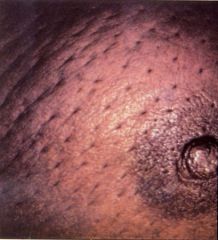![]()
![]()
![]()
Use LEFT and RIGHT arrow keys to navigate between flashcards;
Use UP and DOWN arrow keys to flip the card;
H to show hint;
A reads text to speech;
15 Cards in this Set
- Front
- Back
|
what is the most common breast malignancy? |
carcinoma - glandular tissue |
|
|
what is the most common breast carcinoma? what is the other type? |
most common = ductal other = lobular |
|
|
what is it called when ductal carcinoma spreads to the nipple through the duct? |
paget's disease of the breast |
|
|
what is the difference betw. in situ and invasive? |
in situ = still in the duct or lobule, cannot cause death on it's own invasive = invades other structures |
|
|
why does peau d'orange occur? |
lymphatic obstruction causing localised oedema, the hair follicles are anchored so form little pits |
|

what is this called? |
peau d'orange |
|
|
what is a stromal cell vs. paranchymal |
stromal = supporting/connective parenchymal = bulk of tissue/glandular |
|
|
what is a phyllodes tumour? are they malignant? |
a tumour consisting of stromal (connective) tissue as well as epithelial low grade = benign high grade = malignant |
|
|
what is DCIS? |
ductal carcinoma in situ - earliest stage of cancer |
|
|
what is the screening programme for breast cancer? |
mammography every 3 years 50-69 |
|
|
what does a mammography look for? |
microcalcification |
|
|
if micro-calcification is detected in a mammogram what happens? |
fine needle aspiration, core biopsy and/or excision biopsy |
|
|
what are the flaws of mammograms? |
1. exposure to radiation 2. micro calcification isn't specific to breast cancer |
|
|
what is the triple approach? |
1. breast clinician 2. radiologist 3. cellular pathologist |
|
|
what is the most common benign breast neoplasia? |
fibroadenoma aka breast mouse |

